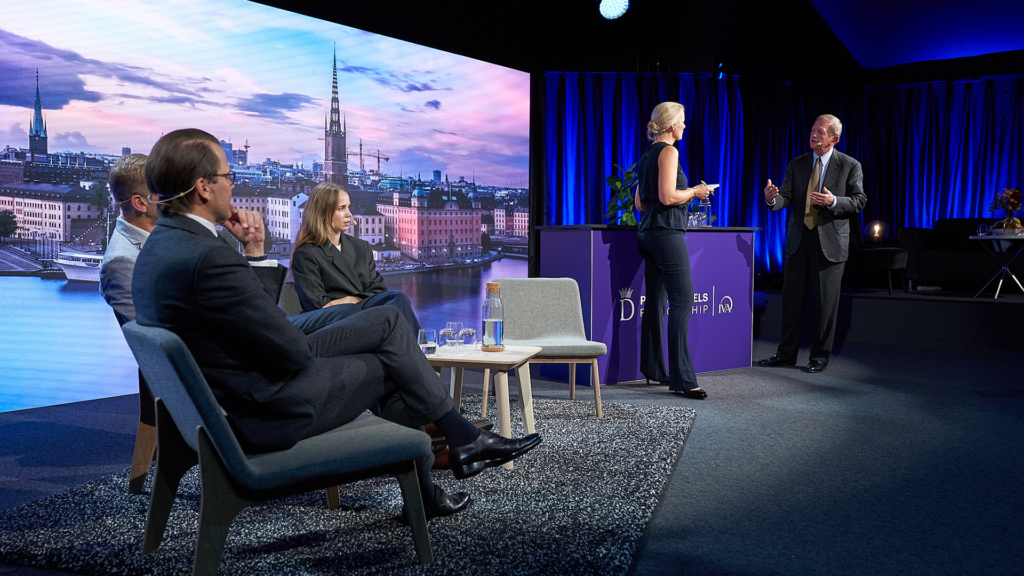10. Mardrömmen
Om att inte ställa in utan ställa om.
Den tionde drömmen – Mardrömmen.
Strax efter nyåret kom de första varningssignalerna. Ett par månader senare rammade Covid-19 världen med förödande kraft; den stannade av, gjorde halt. Virusets framfart slog sönder verksamheter, stängde ner hela städer, skärmade av kontinenter och framförallt, det drabbade miljoner människor och familjer oerhört hårt.
Den viktigaste rekommendationen var, här hemma såväl som i världen: håll avstånd, undvik att samlas. För Adapt, liksom för hela event- och mötesbranschen, var det naturligtvis ett dråpslag. Det blev tvärstopp. Allt, precis allt, bokades av. Välfyllda orderböcker tömdes över en natt. Det var som att springa rakt in i en vägg. Det var många som tänkte: ”Nu är det slut. Nu dör vi”.
Men, du känner ju Adapt vid det här laget, eller hur!
Snabbt gjordes en lägesanalys. Den visade: ”Okej, vi har två val. Vi kan avvakta, vänta, gå i idé. Eller så tänker vi snabbt om och nytt och frågar oss: vad behövs nu?” Svaret var givet: det som behövdes var digitala lösningar som kunde ersätta möten, event, utställningar och mycket annat.
De duktiga drivna människorna fanns. Inte minst David Oxe och Klas Öberg, som var ruskigt bra på det där med tv-produktion, streaming och kameralösningar. Allt och alla fanns i huset. Men så var det frågan om lokaler.
Men visst ska man ha lite tur också. När detta hände var renoveringen av de nya lokalerna i Stockholm i full gång. De skulle bli till ett nytt kontor och en samlingsplats för branschkollegor. Så det blev att snabbt dra i handbromsen och peka ut en ny riktning: ”vi ska bygga streamingstudios!”
Nu gick det i rasande fart. Redan i mitten på mars stod den första studion klar i Stockholm och bara några veckor senare var det premiär för Göteborg, också det i nya lokaler på Svenska Mässan Gothia Towers. I tillägg till det lanserades en helt mobil TV- och streamingstudio. Det var noll broms och gasen i botten på alla håll. Sällan har metaforen varit så precis: man byggde båten under det att man seglade den.

Men heter man Adapt så gör man. ”Vi tänkte om och gjorde om och så marknadsförde vi det som satan.” Det var minsann annorlunda tider.
Effekten av den blixtsnabba omställningen blev att Adapt tog en tätposition i branschen. Satsningen fick snart ett eget namn och hemsida: Studio Adapt. Gamla såväl som nya kunder strömmade till med uppdrag och förfrågningar om digitala möten, presentationer, lanseringar, stämmor och mycket annat. Efterfrågan ökade successivt och fler studios kunde planeras och börja byggas.
När sommaren kom var man ganska häpna och väldigt glatt överraskade över hur bra det ändå gått. Trots att alla bokningar hade raderats bara några månader tidigare. Trots att lagret i Linköping i princip stod stilla och utrustningen samlade damm. Det hade varit full verksamhet i de nya studiorna och intäkterna såg ganska bra ut. Efter en kort sommarvila blev det höst – och nu var orderböckerna fulla igen. Och Studio Adapt blev fem.
Totalt tre studios stod under hösten klara i Stockholm och två i Göteborg. Dessutom lanserades en stor hybridstudio i Svenska Mässans B-hall med scen- och studiolösningar anpassade för att ge alla deltagare, de på plats samt de på distans, en gemensam och lika fantastisk upplevelse. Och inte bara det. Slutsatsen blev att framtiden hade visat sitt rätta ansikte; och framtiden stavas hybrid. Man såg att det kommer att finnas plats för och behov av fysiska möten i olika former precis som att digitala streamade möten och events har kommit för att stanna. Därtill ska läggas kombinationen av de båda: den perfekta hybriden, live och digitalt.
När Jonathan och Viking och alla de andra på Adapt kunde se tillbaka på 2020, var det inte tu tal om att det var det i särklass mest omtumlande och omvälvande året någonsin. Inte bara för Adapt utan för hela mötesbranschen. Samtidigt blev det Adapts mest innovativa och utvecklande år hittills. Man hade skapat ett helt nytt affärsområde, fått fler företagskunder än någonsin förut, partnerskapet med eventbyråerna hade förstärkts och erbjudandet hade breddats med innehåll och design.
Nyckeln till att klara en så stor omställning var ett tydligt ledarskap, ett dedikerat samspelt team, en urstark position på marknaden samt givetvis en gnutta tur och timing. En avgörande faktor var också att man tidigt bestämde sig för att göra digitala event – och inte att göra tv-produktioner eller tv-program av eventet. Det fanns en enkelhet och tydlighet i det som förstods och uppskattades av kunder och partners. Den mardröm som drabbade världen hade Adapt förvandlat till en ny dröm, en ny möjlighet. För som ni vet, det är så de fungerar.